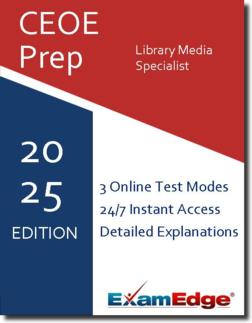CEOE Library-Media Specialist (038) Practice Tests & Test Prep by Exam Edge - Topics
Based on 28 Reviews
- Real Exam Simulation: Timed questions and matching content build comfort for your CEOE Library-Media Specialist test day.
- Instant, 24/7 Access: Web-based CEOE Library-Media Specialist practice exams with no software needed.
- Clear Explanations: Step-by-step answers and explanations for your CEOE exam to strengthen understanding.
- Boosted Confidence: Reduces anxiety and improves test-taking skills to ace your CEOE Library-Media Specialist (038).

Understanding the exact breakdown of the CEOE Library-Media Specialist test will help you know what to expect and how to most effectively prepare. The CEOE Library-Media Specialist has 80 multiple-choice questions and 1 essay questions. The exam will be broken down into the sections below:
| CEOE Library-Media Specialist Exam Blueprint | ||
|---|---|---|
| Domain Name | % | Number of Questions |
| The School Library Program | 25% | 24 |
| School Library Resources and Collections | 22% | 21 |
| Information Literacy and Inquiry Skills | 22% | 21 |
| Program Administration | 16% | 15 |


